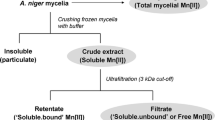Abstract
The role of cyclic adenosine monophosphate (cAMP) during growth and development of Aspergillus nidulans was investigated. In normal cultures the highest amount of cAMP, expressed on a dry weight basis, was found after 24 h of growth when still more than 5% glucose was present in the medium. After depletion of the medium even a slight fall in cAMP was noted. Glucose concentrations ranging from 0.5–12% resulted in a slight decrease in the amount of cAMP as measured after 24 h of growth.
Cultures with manganese deficiency resulted in a low cAMP level after 24 h of growth. However, the exhaustion of glucose in the absence of manganese was connected with a sharp increase in cAMP. This indicates that manganese shortage was not a direct cause of the low cAMP level after 24 h. The amount of cAMP rose with increasing concentration of manganese in the medium until a maximum at 0.25 μM. It is tempting to speculate that this rise in cAMP in the manganese deficient culture is explained by the absence of glucose, that in the control culture is derived from the breakdown of the reserve material α-1,3-glucan.
Addition of manganese after glucose exhaustion to a manganese deficient culture induced cleistothecium formation. However, they contained only a few ascospores indicating the importance of α-1,3 glucan as a carbon and energy source for ascospore formation. The regulation of the level of cAMP by the transport of glucose into the cell or its intracellular concentration is discussed.
Similar content being viewed by others
References
Abou-Sabé, M., Burday, M., Gentsch, I.: On the regulation of adenosine 3′, 5′ monophosphate synthesis in Bacteria. I. Effect of carbon source variation on cyclic AMP synthesis in Escherichia coli B/r. Biochim. biophys. Acta (Amst.) 385, 281–293 (1975)
Bonner, J. T.: Induction of stalk cell formation by cyclic AMP in the cellular slime mold Dictyostelium discoideum. Proc. nat. Acad. Sci. (Wash.) 65, 110–113 (1970)
Clutterbuck, A. J.: Cyclic AMP levels during growth and conidiation. Aspergillus News Letter No 12, 13–15 (1975)
Epstein, W., Rothman-Denes, L. B., Hesse, J.: Adenosine 3′, 5′-cyclic monophosphate as mediator of catabolite repression in Escherichia coli. Proc. nat. Acad. Sci. (Wash.) 72, 2200–2204 (1975)
Konijn, Th. M., Barkley, D. S., Chang, Y. Y., Bonner, J. T.: Cyclic AMP: a naturally occurring acrasin in the cellular slime molds. Amer. Naturalist 102, 225–234 (1968)
Leighton, T. J., Doi, R. H., Warren, R. A. J., Kelln, R. A.: The relationship of serine protease activity to RNA polymerase modification and sporulation in Bacillus subtilis. J. molec. Biol. 76, 103–122 (1973)
Schlanderer, G., Dellweg, H.: Cyclic AMP and catabolite repression in yeasts. Europ. J. Biochem. 49, 305–316 (1974)
Silverman, P. M., Epstein, P. M.: Cyclic nucleotide metabolism coupled to cytodifferentiation of Blastocladiella emersonii. Proc. nat. Acad. Sci. (Wash.) 72, 442–446 (1975)
Tovey, K. C., Oldham, K. G., Whelan, J. A. M.: A simple direct assay for cyclic AMP in plasma and other biological samples using an improved competitive protein binding technique. Clin. chim. Acta 56, 221–234 (1974)
Trinci, A. P. J.: A study of the kinetics of hyphal extension and branch initiation of fungal mycelia. J. gen. Microbiol. 81, 225–236 (1974)
Uno, J., Ishikawa, T.: Effect of glucose on the fruit body formation and adenosine 3′, 5′-cyclic monophosphate levels in Coprinus macrorhizus. J. Bact. 120, 96–100 (1974)
Voichick, J., Elson, C., Branner, D., Sharago, E.: Relationship of adenosine 3′, 5′-monophosphate to growth and metabolism of Tetrahymena pyriformis. J. Bact. 115, 68–72 (1973)
Van Wijk, R., Konijn, T.: Saccharomyces carlsbergensis under various conditions of catabolite repression. FEBS Letters 12, 184–186 (1971)
Zonneveld, B. J. M.: A new type of enzyme, an exo-splitting α-1,3 glucanase from non-induced cultures of Aspergillus nidulans. Biochim. biophys. Acta (Amst.) 258, 541–547 (1972a)
Zonneveld, B. J. M.: Morphogenesis in Aspergillus nidulans. The significance of α-1,3 glucan of the cell wall and α-1,3 glucanase for cleistothecium development. Biochim. biophys. Acta (Amst.) 273, 174–187 (1972b)
Zonneveld, B. J. M.: α-1,3 glucan synthesis correlated with α-1,3 glucanase synthesis, conidiation and fructification in morphogenetic mutants of Aspergillus nidulans. J. gen. Microbiol. 81, 445–451 (1974)
Zonneveld, B. J. M.: Sexual differentiation in Aspergillus nidulans. The requirement for manganese and its effects on α-1,3 glucan synthesis and degradation. Arch. Microbiol. 105, 101–104 (1975a)
Zonneveld, B. J. M.: Sexual differentiation in Aspergillus nidulans. The requirement for manganese and the correlation between phosphoglucomutase and the synthesis of reserve material. Arch. Microbiol. 105, 105–108 (1975b)
Author information
Authors and Affiliations
Rights and permissions
About this article
Cite this article
Zonneveld, B.J.M. The effect of glucose and manganese on adenosine-3′, 5′-monophosphate levels during growth and differentiation of Aspergillus nidulans . Arch. Microbiol. 108, 41–44 (1976). https://doi.org/10.1007/BF00425091
Received:
Issue Date:
DOI: https://doi.org/10.1007/BF00425091




